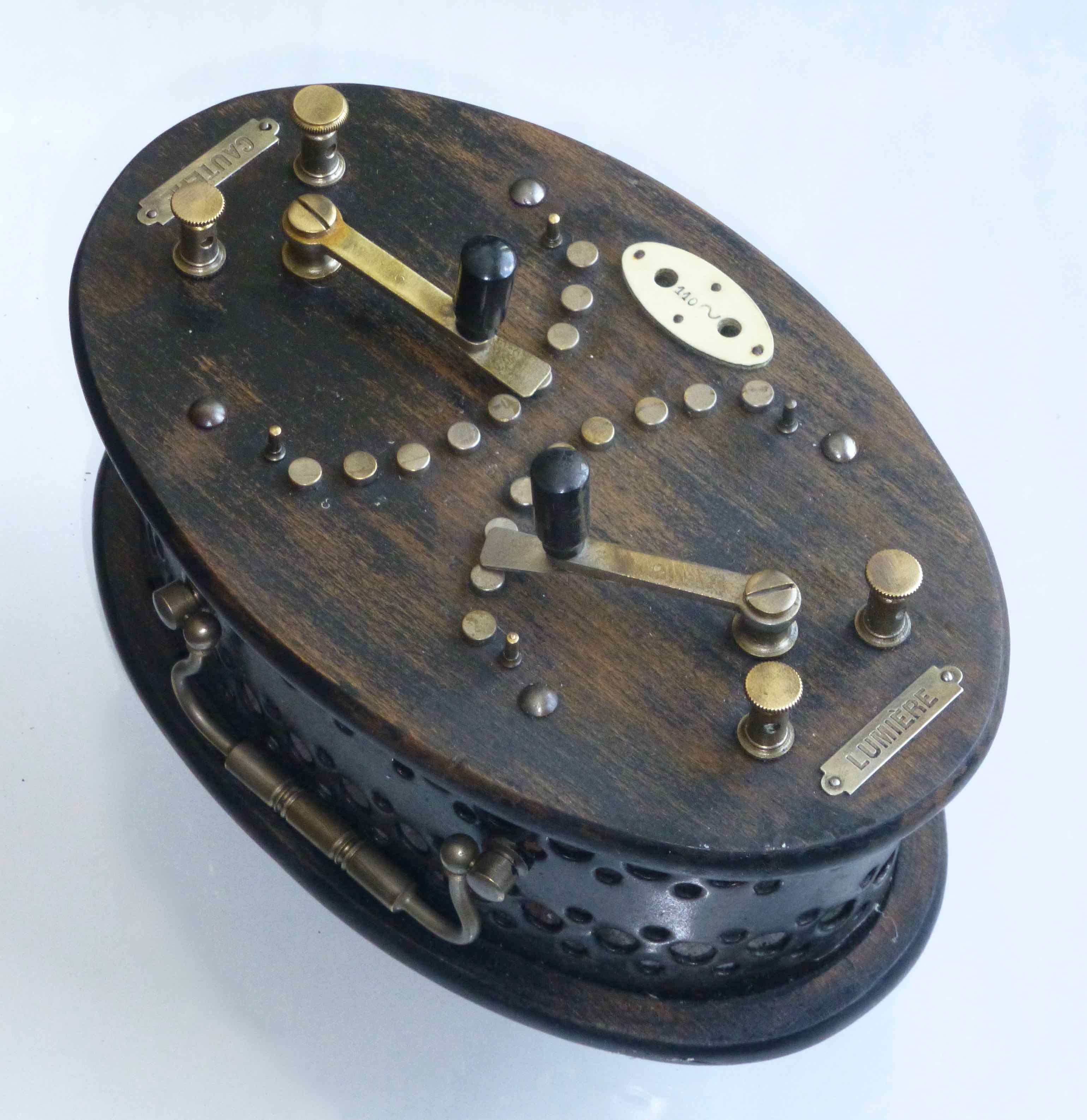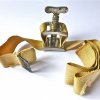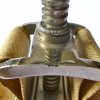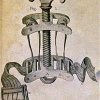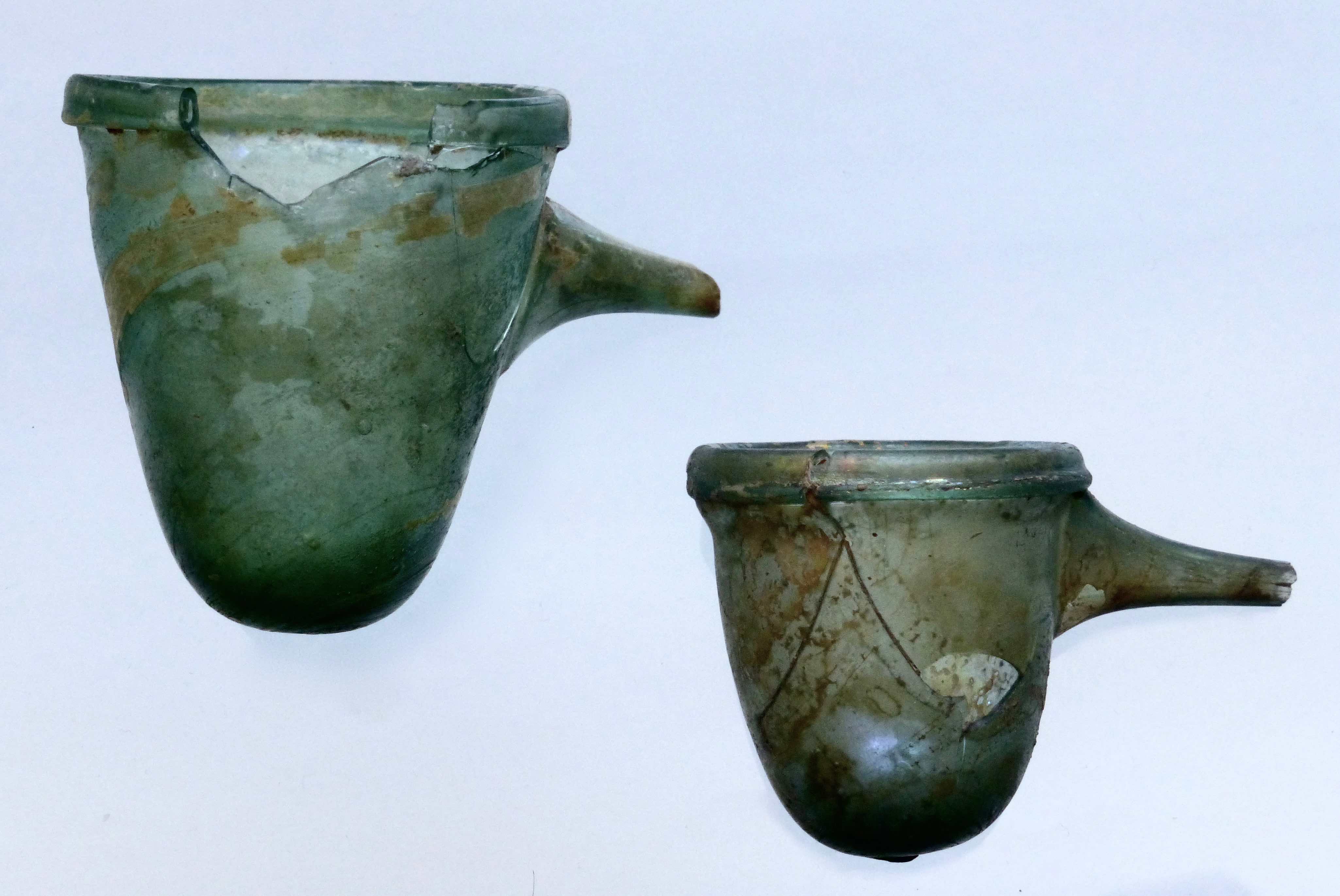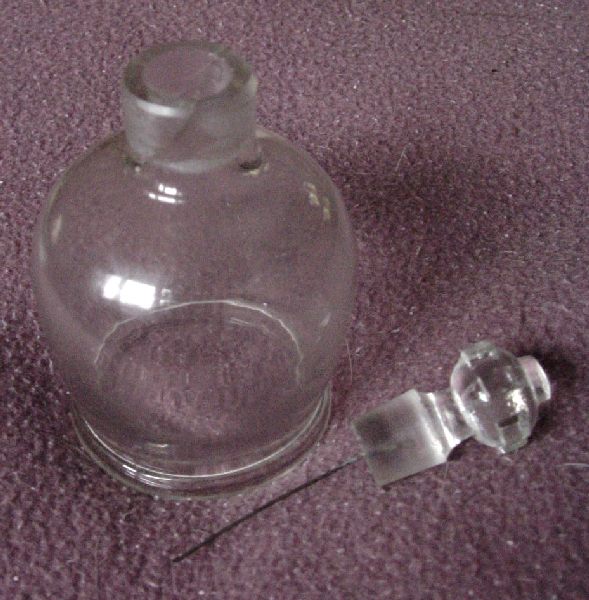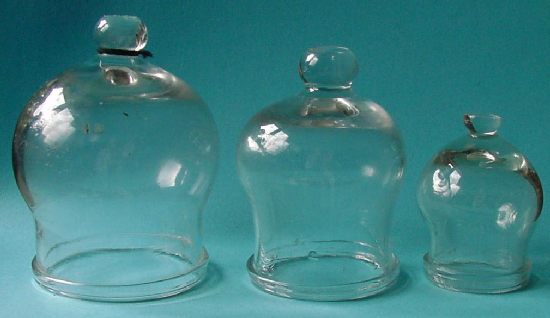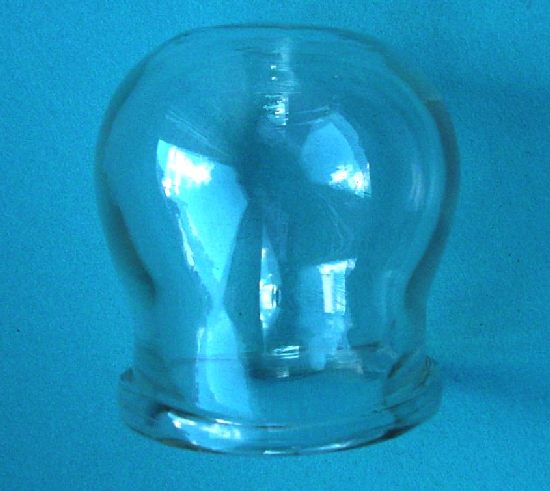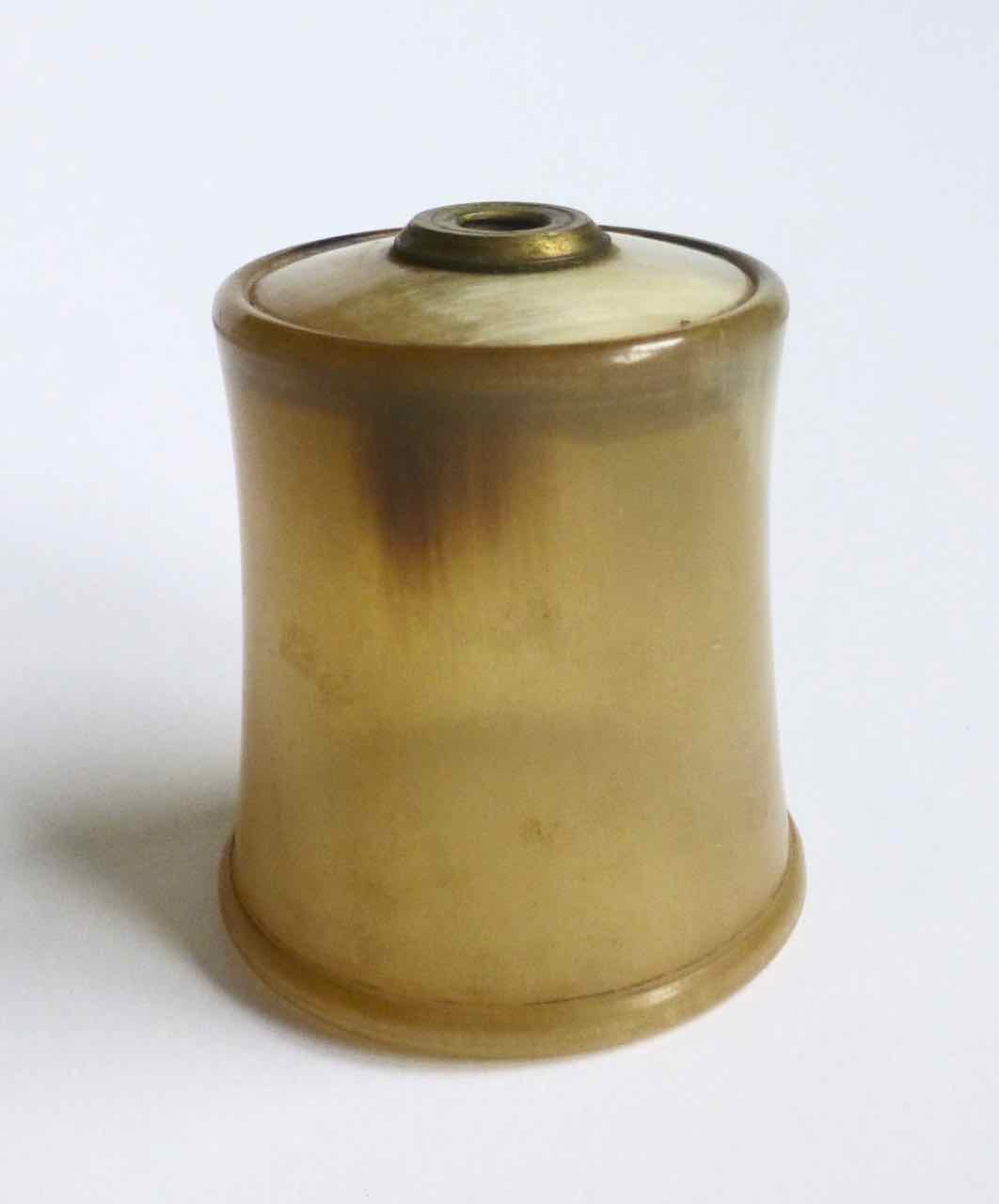Surgery |
||
Cautery (8), transformator |
||
In 1845, the Viennese dentist Moriz HEIDER (1816-1866) killed a tooth nerve by means of electrically heated platinum wire - in an interview with the physicist Carl August von Steinheil (1801-1870), who lives in Munich (Alsace), he came up with the idea to replace the usual annealing iron by a glowing by electric current platinum wire.
|
Surgery |
||
Coating gelatine |
||
In order to bring the instruments needed on the Western Front as cheaply as possible, and as little as possible scratched to Europe, the Ami's welded the instruments into a paraffin mass. If the instruments were placed in hot water, then the "coating" dissolved, the instruments were available within a very short time and in perfect condition.
After the invasion of Luxembourg, the American troops left a portion of their funds back in Luxembourg, where it was mothballed by the Luxembourg army - and scrapped in 1950. |
Surgery |
||
Compression bandage |
||
|
The compression of a severely bleeding vein took place chemically in the first attempt: a) by etching blood vessels with copper vitriol; b) Compresses were soaked in brandy c) a fungus was commonly used: the (burst) bovist, which, dried, was used as a hemostatic dressing, which is why it was called "fungus chirurgorum" (fungus of surgeons).
Only when chemicals were not available and neither finger pressure nor Umstechen *, nor burning helped, only then applied the surgeon a pressure bandage. The German Wilhelm Fabry von Hilden (1560-1624) and Hans von Gersdorf are said to have used a primitive form of Garrot, a wooden peg that was slid under a ligature from a hairnet and turned off.
* The invention of the mass ligature is attributed to the Besançon surgeon Etienne Jean MOREL (1648-1710), who was said to have used a toggle tourniquet in 1674 at the Battle of Besançon (Seerig AWH, Armamentarium chirurgicum or as complete a collection of illustrations and descriptions of surgical Instruments of older and more recent times Volume I-II and ribbon with 145 lithographed plates Breslau: A Gosohorsky 1838) - un simple lien circulaire, garrotté autour du membre au moyen d'un bâton. Morel appela cet instrument par conséquent un "garrot". (See "la garrotte", the choking iron).
In 1674 au siège de Besançon, un chirurgien nommé Morel imagina de comprimer les vaisseaux sanguins par un appareil de sa fabrication: un garrot circulaire comportant une cheville dont on réglait la tension en la tournant sur elle-même, d'où le nom de tourniquet Régulièrement perfectionné, cet appareil fut utilisé jusqu'au 19e siècle, Bien que l'hémostase dans les amputations des membres ait encore été améliorée par l'utilization tourniquets à vis, la mortalité suite aux infections resta élevée "(Musée).
Morel had used his device for emergency hemostasis, the French surgeon Jean Louis PETIT (1674-1750) devised a device for use in planned amputations. His device no longer compressed the entire limb, but only the heavily bleeding main trunk of the artery. In 1718 he published the picture of his screw-type journal, which he called "tourniquet à vis", which gradually compressed the extremity to be amputated - the idea of the instrument. First versions made of wood, later made of metal. (tornaculum, torquilar).
Heister has improved the device in 1740. Nevertheless, ES had a very unpleasant feature: the tendency to topple over. "plus la pression est forte, plus la plaque supérieure s'élève, l'appareil devient trop pour pour base, le moindre choc le renverse, ou pendant l'opération par les mouvement du malade et la contraction des muscles, ou après, par quelque choc imprévu, ce qui occasionne souvent une hémorrhagie promptement mortelle "(HV Malan, Recherches sur un nouveau tourniquet, in: L'Esculape, gazette des médecins praticiens n ° 1 du 7 février 1841, p. 82)
The putting on of the tourniquet was painful. Often valuable time was lost. Many surgeons considered tourniquets to be superfluous, indeed dangerous (Robert Liston, Commentaries on Tourniquets, in: Edinbourgh Medical Surgical Journal, Jan. 1854, cited in: Notes from the Field of Natural and Medical Science, 1824, p ). It was only in the 18th century that Petit's Arteriabbinder came into use to a greater extent. Bleeding from the limb was often too intense, although blood could not flow back to the heart, but the influx of arterial blood was not really prevented by insufficient compression.
Exhibit The handle of our tourniquet is identical to the copy reproduced by Anton Bum (1856-1925) "Therapeutic Encyclopedia, Practical Doctors, Urban & Schwarzenberg, Vienna, 1891" p. Dating therefore around 1890). |
Surgery |
|||
Cryocautery |
|||
Cryotherapy and cooling agents were already known in antiquity, cold blockage was probably first used by Larrey for amputations in 1812. However, cryosurgery as it is today begins with Sir James Arnott, who arrived in the mid-19th century with an ice-salt mixture Temperatures below -20 ° C and necrosis in tumors were further progressed, as liquefaction and separation of gases using the Linde process on an industrial scale was successful, and Dewar and Weinhold developed suitable insulated vessels White used the application of liquid air as a spray and with cotton wool, and 1910 gold liquid oxygen, both of which were used despite warnings of the risk of explosion until the 1930s. "(M. Hundeiker, History and Future of Cryosurgery in Dermatology, in: Akt. Dermatol 2009; 35 (7): 279-282).
The doctor filled the cold-insulated handle with ice snow, chose a probe adapted to the lesion to be treated, adjusted the pressure with which he wanted to force the probe onto the lesion, and informed himself in the literature about the adequate duration of treatment - and warned the patient about the procedure expected slight pain.
The cautery was available in different packs: with 2, 5, 8 or 10 hollow probes, always together with an adapter with which the handle could be refilled from an original ice bomb supplied by Drapier. In addition to 10 skin probes, a clinic pack contained 3 gynecological probes according to Bizard and Rabut, with which uterine skin and cervical inflammation could be treated.
We present an icing device according to Léon LORTAT-JACOB (1873-1931) from the possession of the physician Paul HETTO (1895-1979) established in Diekirch.
|
Surgery |
||
Cupping glass (01) |
||
Already in ancient times one knew suction cups - on several Greek and Roman reliefs the "cucurbiculae" are pictured. There was the intervention in two variants: - in bloody "wet" cupping the skin was scratched, then placed the suction cup over it to draw blood from the skin wound
A Roman bronze plate is featured in our collection under the heading "Ancient Medicine". In addition, they were available in horn, in wood and in glass.
While the "Greek-Roman" bell was fixed to the skin by means of a flame, the fore-oriental surgeons preferred to suck the bells with their mouths. For this purpose, the bells had a - below the edge inserting - Saugstutzens. Several museums (Cairo, Louvre) as well as several private collections know this kind of glasses, which are from 7.-13. Century were produced and are a nice document for the high standing Islamic medicine ...
Two glass bells made of green, slightly iridescent glass are presented: - large bell (left in the picture): H 5.6 cm; Diameter 5.0 cm. - small bell (right in the picture): H 4.0 cm; Diameter 3.9 cm. In both bells, the originally about 10 cm long intake manifold is broken and measures only 2.5 cm (large bell), resp. 3.0 cm (small bell). |
Chirurgie |
||
Cupping glass (02) |
||
Extremely thin-walled suction cups of the French company EPY, awarded the silver prize in 1923 at the Concours Lépine. The hollow tip handle was also used to attach the wad of cotton wool "Introduce un tampon de coton dans le creux du bouton et laisser dépasser légèrement, présenter le coton à la flame and pose immédiatement, le coton étant tenu ne peut tomber ni brûler le malade", their burning produced the negative pressure in the bell.
The "Concours Lépine" was founded in 1901 by the Paris police prefect Louis Lépine (1846-1933), who himself was an ingenious inventor - ia. He invented the roundabout, driver's license and speed limit for motorized vehicles. Initially, the winner received 100 francs as a reward for an invention in the field of toys and small items. The purpose of the competition was to pull the Parisian factory out of the financial swamp and to better withstand the competitive pressure from Germany ... Lépine was later a politician.
Flea market Luxembourg 9/2005. |
Surgery |
||
Cupping glass (03) |
||
The increase in blood flow in a particular skin segment led to the withdrawal of the blood from a lower organ: this effect was called "revulsive" or "effet par révulsion".
If the cupping glass was placed on the chest, this helped against pneumonia and bronchitis, and if the cupping glass was placed on the abdomen, it helped against abdominal pain, whatsoever, the cupping head was placed on the back, helping against back pain.
And then? What happened after removing the suction cup? We read in the "Cours complet de Surgery" by Benjamin BELL (1749-1806) (vol. I, p. 91): "on a nice story about plaies et on a recouvre d 'un petit linge doux ou de charpie, trempés dans un peu de lait ou de crème, tout autre appareil est inutile "- around 1796 the wound was covered with a milk or cream dressing!
Exhibit The suction cup shown here has a glass plug, in which a metal wire is incorporated. To this wire a small cotton ball was attached, which was soaked with spirit. While he was still burning, he was pushed through the hole, the bell attached to the patient. The flame went out because of lack of alcohol, partly because of lack of oxygen.
Here is the description of the trader from Amsterdam: "Oude Ventouse 2 onderdelen: klok met stop in belepen glass." Onderaan de stop bevind a ijzerdraad (inox?). Op deze ijzerdraad prikte men a propje watte gedrekt in iets brandbaars, vervolgens plaatst men de klok op het lichaam (op een slangenbeet, een geïnfecteerde wonde, ...), du watte aan en plaatst de stop voorzichtig in de klok Doordat de zuurstog de ventouse verdwijnt zuigt de klok de 'kwade sappen' uit de Thanks also to the glass of the klok makkelijk weer, Deze Ventouse, from the name of the "Superventouse Sans Souci", is the name of the company.
The risk of burns to the skin of the patient was high, that is why we rarely find this type of cupping glas. |
Surgery |
||
Cupping glass (04) |
||
"While cupping glasses with a diameter of 5 or 6 cm can certainly be used in the large areas of, for example, the deltoid, such large cupping glasses, for example in the area of the strongly rounded neck muscles, would never lead to vacuum." Diameter of 2 or 3 cm If you want to be a professional cupping therapist, you can not help getting a collection of cupping glasses in at least 5 different sizes".
A series of three "cupping glasses" with descending diameters is presented - adapted to the size of the available area and the respective skin curvature ...
It goes without saying that you can also convert wine glasses to suction cups. And many a cupping glass may turn out to be a sawn off Bordeaux glass on closer examination. Therefore beware of suction glasses with too thin edge!
Occasionally you can still find glassblowers who make cupping glasses by hand and respond to special customer requests: www.schroepfglas-shop.de/ |
Surgery |
|||
Cupping glass (05) |
|||
In old times the application of a cupping glass was part of the first aid in cas you were bitten by a dog:
We present a hand blown cupping glass with trapped air bubbles, irregularly thick rim, without bevel. |
Surgery |
||
Cupping glass (06) |
||
In the midwifery school Luxembourg-Pfaffenthal the use of the suction bells was taught to the students around 1900 with all details. So we read in the exercise book of Margarethe WEYDERT from 1897: "Belong to a cupping apparatus
We show several varieties of suction cups: a) a rare, 65 mm high bell "Eclair, Breveté SCDG" with two lateral depressions (purpose unknown) b) a 7o mm high bell with a polished bottom, next to a rare, only 43 mm high bell that could be applied to a child or could put on uneven areas of skin such. the temples. c) Bell with a spherical handle ("cloche à bouton"); Height 73 mm d) while in the aforementioned bells the vacuum was created by the bather resp. Doctor surgeon heated the air in the interior with a Kienspan and the bell tightened to the skin when the air cooled, developed in the 19th century bells, the cold, i. without putting fire on the skin, creating the vacuum by pulling off the air with a hand pump. The model presented here "La TENON" with its valve belongs to such a cutlery. |
Surgery |
||
Cupping glass (07) |
||
In traditional China, the cupping heads were made from horns of horns (cow and antelope horns), and later from bamboo. Bamboo is a mythical material in the Far East - think of Malakas and Maganda, the first human couple to have sprung from a split bamboo according to Philippine mythology.
Patients feel the bamboo tubes completely different than glass bells, which emit less heat, because with them only the air is warmed up. There are a number of differences to the classic glass bells.
- Bamboo cupping heads are not sucked in by mouth, nor with hot air: they are boiled in the herb broth and then put on the skin: this process is therefore called "wet cupping head". Cave burns with the bamboo tubes taken from the hot brew!
- Since the edge of the glass bells is usually worked somewhat beaded, while the lower edge of the bamboo tubes is rather thin, take the bamboo bells on the skin less space, you can therefore accommodate their more in a tight space.
- Bamboo tubes cut a bit because of their narrow rim - the pain that causes them is one of the reasons why bamboo bells are now rather unpopular.
- Another reason for their disappearance from the market is that they can not be reliably sterilized.
- As bamboo tubes cool down more slowly than glass bells, which only heat the air, they adhere more slowly - not to hurried therapists.
Exhibit: 2 bamboo suction pipes, Shanghai 2016. |
Surgery |
||
Cupping glass (08), horn |
||
Suction cup made of horn in the shape of a tumbler. Height 4.8 cm, Ø bottom 3.6 cm, Ø lip 4.6 cm. Origin: Olathe, Kansas, United States.
A similar glass from the 4th century AD. was found in Worms: "The use of cupping heads has been handed down since antiquity, and for better blood circulation, a heated cupping cup was placed over a small skin suture, so that it sucked and drew out the blood." Cupping heads are known and made of metal, ceramics, bone, horn and glass The figure of Lüneburg shows just how similar the shape of the cupping glasses has been over a long period of time: for there is an externally absolutely identical piece from Roman Worms, which becomes one The small interior volume of the cupping glasses predestined it even for use as a reliquary container until the 19th century, as some examples from relevant find correlations prove.As with the small vials, glass cupping heads are also a single object sc to date, since the function predated the form for centuries "(Peter Steppuhn, in: Glass Culture in Lower Saxony, 2003, 14 p.171-175).
A similarly shaped cup made of light green, bubble glass from the 16./17. Century was also found in Lüneburg (City Hall, Court Arbor - West Wall / Kloake). H max. 4.4 cm; Ø bottom 4.0 cm; Ø lip 3,4 cm; Gd. 0.7 mm; Gd. Lip 2.9 mm.
The bloody cupping as emergency therapy "The time of need / when one must leave / when one can not wait any longer: than when a child has pleuresin / side stitch / and is so young / which one does not let him / her / it should be allowed to let him Köpffe and the scarificiren instead of the Aderlassung "(Petrus of the Stylle, Balbierer and Wundtartzt, Handbuch der Chirurgiae, Frankfurt am Mayn, 1611 p.245). Cupping heads, also called Laßköpfe, in baierischen space rather Loßkopf (ceramic, non-ferrous metal or glass) were in the early modern times as a remedies and health care often in use - the bronze rather in Germany, the glass rather in Italy: In Germany, small brass heads are used for this purpose, which are put on first, and then cut the skin with the cupping cup, which is of the same size as the leaves, and yet makes fifteen, sixteen small cuts in one go Italy has glassy, and much larger lass heads "(Johann Alexander von Brambilla, About the Inflammatory-Schwolst and their exits, Vienna 1786) p.458). |




